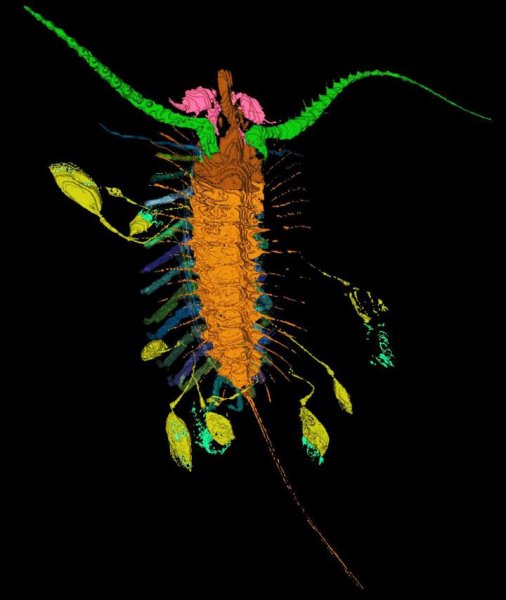Scientists have discovered an ancient animal that carried its young in capsules tethered to the parent’s body like tiny, swirling kites. They’re naming it after “The Kite Runner,” the 2003 bestselling novel.
The miniscule creature, Aquilonifer spinosus, was an arthropod that lived about 430 million years ago. It grew to less than half an inch long, and there is only one known fossil of the animal, found in Herefordshire, England. Its name comes from “aquila,” which means eagle or kite, and the suffix “fer,” which means carry.

Aquilonifer spinosus, the Kite Runner, was an arthropod that lived about 430 million years ago. It carried its young in capsules or pouches tethered to its body.
Credit: D. Briggs, D. Siveter, D. Siveter, M. Sutton, D. Legg
Researchers from Yale, Oxford, the University of Leicester, and Imperial College London described the new species in a paper published online the week of April 4 in the journal Proceedings of the National Academy of Sciences.
“Modern crustaceans employ a variety of strategies to protect their eggs and embryos from predators — attaching them to the limbs, holding them under the carapace, or enclosing them within a special pouch until they are old enough to be released — but this example is unique,” said lead author Derek Briggs, Yale’s G. Evelyn Hutchinson Professor of Geology and Geophysics and curator of invertebrate paleontology at the Yale Peabody Museum of Natural History. “Nothing is known today that attaches the young by threads to its upper surface.”
The Kite Runner fossil shows 10 juveniles, at different stages of development, connected to the adult. The researchers interpret this to mean that the adult postponed molting until the juveniles were old enough to hatch; otherwise, the juveniles would have been cast aside with the shed exoskeleton.
The adult specimen’s head is eyeless and covered by a shield-like structure, according to the researchers. It lived on the sea floor during the Silurian period with a variety of other animals including sponges, brachiopods, worms, snails and other mollusks, a sea spider, a horseshoe crab, various shrimp-like creatures, and a sea star. The juvenile pouches, attached to the adult by slender, flexible threads, look like flattened lemons.
Briggs said he and his colleagues considered the possibility that the juveniles were parasites feeding off a host, but decided it was unlikely because the attachment position would not be favorable for accessing nutrients.
“We have named it after the novel by Khalid Hosseini due to the fancied resemblance of the juveniles to kites,” Briggs said. “As the parent moved around, the juveniles would have looked like decorations or kites attached to it. It shows that arthropods evolved a variety of brooding strategies beyond those around today — perhaps this strategy was less successful and became extinct.”
The researchers were able to describe Aquilonifer spinosus in detail thanks to a virtual reconstruction. They reconstructed the animal and the attached juveniles by stacking digital images of fossil surfaces revealed by grinding away the fossil in tiny increments.
Co-authors of the paper were Derek Siveter of the University of Oxford and the Oxford University Museum of Natural History, David Siveter of the University of Leicester, Mark Sutton of Imperial College London, and David Legg of the Oxford University Museum of Natural History.
The Yale Peabody Museum of Natural History, the Natural Environmental Research Council, the John Fell Oxford University Press Fund, and the Leverhulme Trust supported the research.
Citation:Yale University. “Chasing after a prehistoric Kite Runner.” ScienceDaily. ScienceDaily, 4 April 2016. <www.sciencedaily.com/releases/2016/04/160404152916.htm>
Key: WFS,Riffin T Sajeev,Russel T Sajeev,World Fossil Society



 April 5th, 2016
April 5th, 2016  Riffin
Riffin  Posted in
Posted in  Tags:
Tags: 